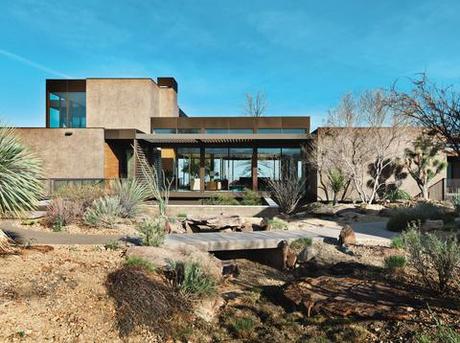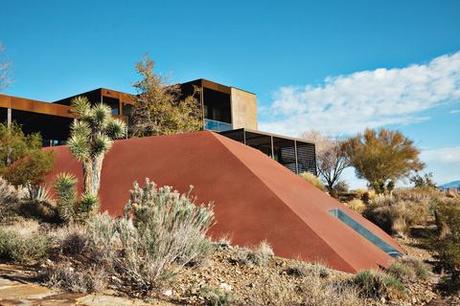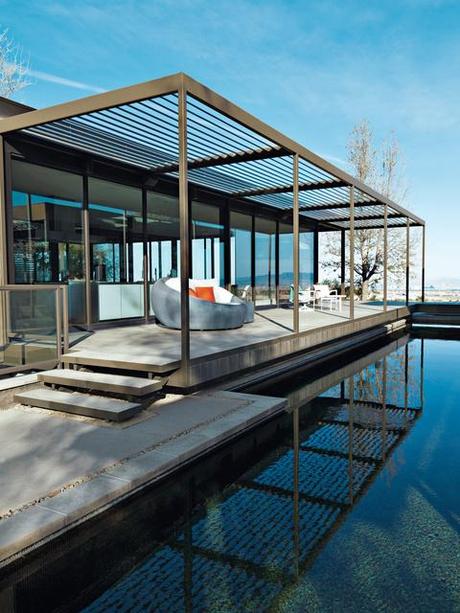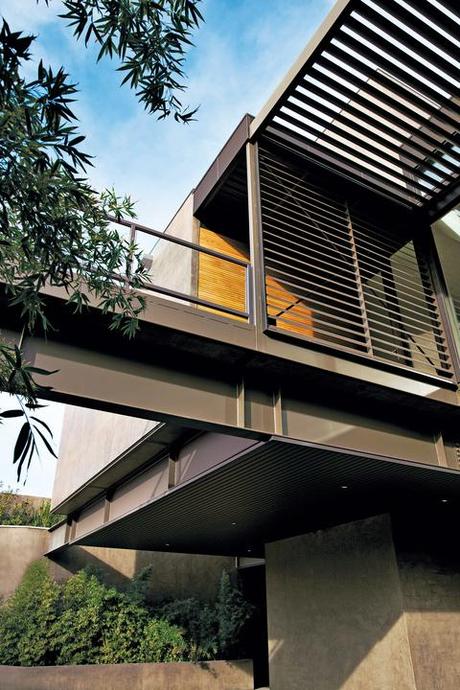
Sage Design Studios transformed the developer-flattened landscape into a picturesque desert setting with naturalistic undulations, meandering trails,and drought-tolerant shrubs. Photo by Jill Paider.
When Jim Murren, a Las Vegas–based casino executive, approached the Los Angeles firm Marmol Radziner for a modern house to complement his hillside desert lot, he hit an architectural jackpot.
Slideshow
Near the main house, James Turrell’s pyramidal Skyspace structure invites visitors into its dark recess for a chance to view the heavens through a perspective-altering cutout. Most of Murren’s museum-quality art collection is inside the house, including a Robert Rauschenberg piece, a set of Andy Warhol prints, and a hologram by Turrell. Photo by Jill Paider.
Murren’s previous home was a Palladian-style villa, but houses like that no longer interested him. “They are not forward-looking,” he says. As chairman and CEO of MGM Resorts International, one of the development companies responsible for Vegas’s LEED Gold CityCenter buildings, Murren was also interested in green architecture. “I support the creation of buildings that have a positive environmental impact, and in Las Vegas I think you need to embrace the desert,” he says. Slideshow
The house’s slatted, anodized aluminum canopies and indoor-outdoor spaces flow into one another. The resin Opal lounge and Square Cube table, with pillows and cushions covered in Sunbrella fabrics, and the teak and powder-coated cast aluminum Silver Dining swivel rocker, are all from the Veneman Collections. Photo by Jill Paider.
While mulling over design ideas for his house, Murren read about Leo Marmol and Ron Radziner’s multi-award-winning 1998 restoration of Richard Neutra’s iconic 1946 Kaufmann House in Palm Springs, California. Impressed, Murren sought out the firm. He discovered that they were also renowned for built-to-last, steel-frame, prefabricated homes that can be installed efficiently almost anywhere—and that Marmol and Radziner had previously collaborated with the artist James Turrell, whose work Murren collects. Murren toured Turrell’s Roden Crater in Flagstaff, Arizona—an oculus to the sky, carved from an extinct volcano—and began envisioning a steel-and-glass building that meshed with its environment.However, fine modern buildings are relatively rare in Las Vegas, where builders are inured to making Caesarian palaces and stucco villas and lack experience in executing clean-lined details. Importing such skills is costly. After considering the site and weighing Murren’s interest in eco-friendly building, “prefab was clearly the best and greenest way to go,” Radziner says. Murren, no stranger to construction, agreed that faster on-site assembly would greatly reduce the inevitable environmental impact of his new home.
Slideshow
Twenty-two 12-foot-wide steel-frame modules were combined to form nine to 14-foot-high rooms that were stacked and bolted together. Ten deck modules added more than 4,700 square feet of sheltered outdoor space. Photo by Jill Paider.
The modular two-story steel-and-glass structure that Radziner and his team devised sits atop a windy ridge on the city’s western edge, near Red Rock Canyon. Its prefabricated components—steel-frame modules that were prepared with finished floors, walls, doors, and fenestration, or were designed as canopied or trellised decks—were all made in Marmol Radziner’s home-building factory, near Los Angeles, and trucked over to the one-and-a-half-acre site. “By going prefab,we compressed our construction time,” says Radziner. “During the four months it took to prepare the two-level concrete basement garage and foundation, the home’s room modules were already being manufactured in California.”The C-plan house Murren moved into three months later—when the interiors and finish work were completed—forms a sheltered rear courtyard. The building, split into two wings linked by a glass-enclosed steel structure, offers public and private zones for Murren and his family. The two-story north wing contains the bedrooms and master bath, while the single-story south wing, dedicated to the kitchen, library, and family room, sits alongside a swimming pool, bordered by a glass-walled pavilion for formal dining. Between the two wings, a below-grade open-air courtyard offers a shady place for Murren’s athletic sons to play. A high-ceilinged, 48-foot-long great room—made of four modules and nearly spanning the length of the courtyard—links the house’s two wings and completes the ensemble. From the glass-walled great room, facing east, one can see the glittering Las Vegas Strip. This is their first prefabricated home, but “my wife and I don’t see any operational differences between this and other houses we have lived in,” Murren says. “It’s not as if we had to give up anything in terms of comfort or quality to go green.” In fact, because Marmol Radziner’s prefabs have to be trucked to their sites, they have built-in enhancements, such as welded, torque-resistant steel framing and factory-fitted doors and glass panels that are braced for winds on the highway. When sandstorms buffet the building, Murren never worries.
Outside, in the sloped rear garden, Turrell’s Skyspace, a four-sided, rust-colored concrete pyramid, contrasts pleasingly with the rectangularity of the prefab. While its ostensible purpose is to provide a square opening through which individuals can observe subtle changes in the sky, this art installation has taught Murren to see his house in a different light.
“Sometimes, when I walk back up the hill with my dogs, I notice how its canopies frame—and are framed by—the sky,” Murren says. “And after dark, when the lights first come on, my favorite spot to stand is not in my home but outside, looking in.”
